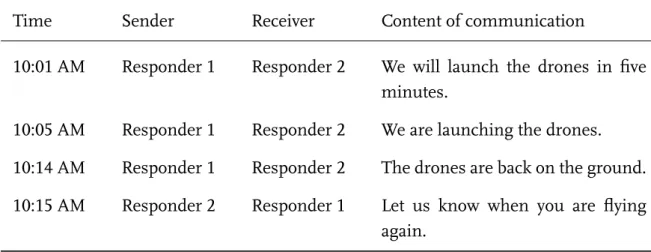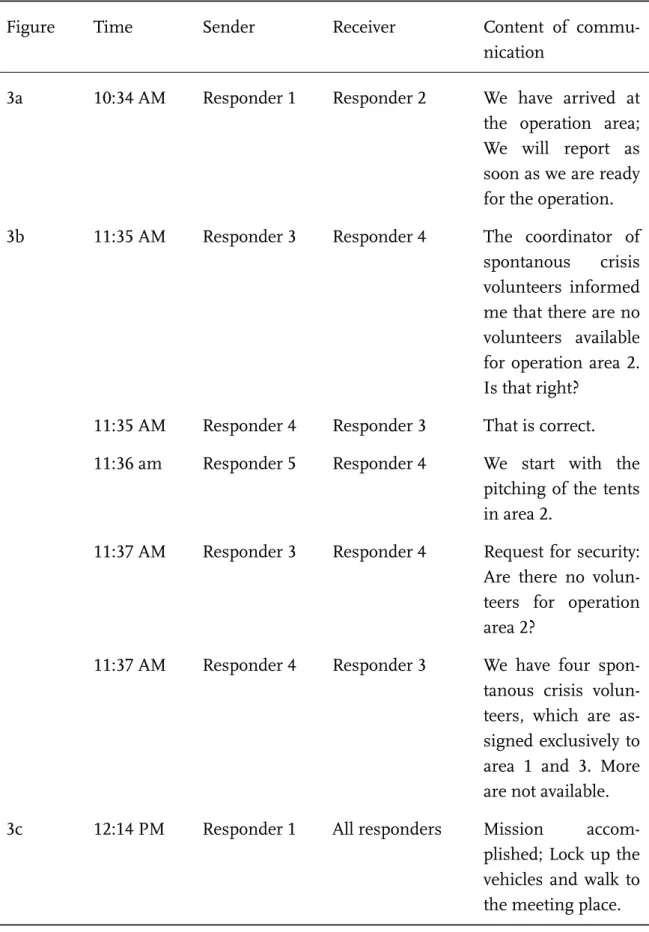Using Social Network Analysis to Make Sense of Radio Communication in Emergency Response
Kathrin Eismann, Diana Fischer, Oliver Posegga, and Kai Fischbach University of Bamberg,
An der Weberei 5, 96047 Bamberg, Germany http://www.uni-bamberg.de/sna/
Abstract. In the wake of an increasing interest in the communication networks of emergency responders, radio communication systems have been recognized as an important source of digital trace data. In this pa- per, we explore how radio data can be used as part of social network analysis (SNA). In particular, we investigate how social networks can be modeled and analyzed based on digital trace data obtained from radio systems in the emergency response field. We outline SNA challenges and opportunities based on radio networks, following the work of [9].
Utilizing radio data from a recent emergency response field exercise, we illustrate an example of a workflow that can be applied for modeling social networks from emergency responders’ radio communication and discuss the implications of our findings for the analysis and interpreta- tion of radio network structures. Hence, this paper is a useful starting point for future research that applies tools and methods from the SNA repertoire to radio networks in the context of emergency response and beyond.
Key words: Social Network Analysis, Radio Communication, Digital Trace Data, Emergency Response
SOCNET 2018, February 28, 2018 85
Introduction
Radio communication – that is, telecommunication by means of radio waves [11]
1– has largely disappeared from the public consciousness but remains a common communication medium in many fields of operation, such as in ground, air, and water transportation, in businesses with factories and other industrial sites, and in care facilities.
Naturally, radio data afford opportunities to apply tools and methods from the repertoire of social network analysis (SNA) to communication networks [1]. While such research was once rare, new interest in the communication networks of emergency responders has emerged in recent years [8,12,13,14,19]. Radio is crucial for emergency responders, especially when other communication infrastructures are compromised or destroyed by disasters or extreme events [10], and has thus remained the baseline communication tool of emergency services in many places [8,14]. Radio interoperability disruptions are still among the most severe commu- nication problems emergency responders face [7,13,15]. Research also suggests that studying radio communication provides unique insights into the social struc- ture of emergency response operations [2,17].
Utilizing radio as a basis for SNA is not without challenges, though. In this paper, we focus on the modeling and analysis of social networks based on radio communication as a special case of digital trace data. We outline key issues in utilizing digital trace data for SNA based on [9] (section 2). We then discuss the SNA challenges and opportunities for radio networks based on our experiences in a research project involving three major German relief organizations, and share our insights from a recent emergency response field exercise (section 3). Finally, we outline the contributions of our work (section 4).
SNA for Digital Trace Data
Digital trace data are “records of activity (trace data) undertaken through an on- line information system (thus, digital)” [9]. Unlike traditional network data, which are produced for research (e.g. from interviews, observations, or archival records
1
In technical terms, radio communication is any transmission, emission, or reception of
signs, signals, writings, images, sounds, or intelligence of any nature using radio waves
(i.e., electromagnetic waves of frequencies arbitrarily lower than 3,000 GHz, transmit-
ted in space without artificial guide such as wire) [11].
[16,20]), digital trace data are found. Furthermore, whereas traditional network data typically describe specific relationships, digital trace data are event-based, and they are longitudinal records of events instead of cross-sectional network snap- shots. Digital trace data thus enable scholars to understand the structure and out- comes of social networks on an unprecedented scale. This type of data does, how- ever, require scholars to make crucial assumptions regarding the nodes, ties, and structures they model from it [9].
According to [9], five steps are necessary to construct and analyze social networks from digital trace data such as radio communication. In the first step, digital trace data have to be understood and interpreted in alignment with the context and char- acteristics of the information systems they emerge from. In this context, issues relating to the reliability of the information systems from which communication events are to be extracted in the first place, as well as practical usage behaviors devi- ating from the intended information systems usage, need to be considered. In the second step, the network elements (i.e., the nodes and links of the network) have to be modeled from the identified communication events. In particular, digital trace data typically allow for different ways to handle the multiplexity, intensity, and directionality of ties. Furthermore, missing ties may be an issue when the records provided by the information system are incomplete or limited to a partial representation of the relationships and interactions within the context of a study.
In the third step, the identified network elements have to be aggregated into a network, which may entail difficulties in the temporal aggregation of nodes and links. In the fourth step, appropriate network measures that align with both the intended theoretical construct to be analyzed and the social network at hand have to be selected. This can be challenging especially if there is mismatch between the temporal dynamics of constructs and network representation, or if software tools applied to support computation of measures yield invalid results. Finally, in the fifth step, the theoretical constructs inferred from the network measures have to be interpreted and generalized in a valid way, which is important for SNA-based research in general, but particularly challenging when working with digital trace data.
In the case of communication networks modeled from radio communication, it
is necessary to initially extract communication events (i.e., instances of radio com-
munication between two or more users of the radio communication system) from
the electronic records of radio communication. Based on this, unique actors that constitute the nodes of the communication network have to be identified from the radio names of users (i.e., the aliases radio users rely on to address their peers).
Furthermore, the trade-offs of considering directed and weighted communica- tion links between these users as opposed to simple undirected and unweighted links, as well as the potential consequences of omitting unobserved communica- tion events have to be discussed. In the next step, several options are available for the temporal aggregation of these network elements, in particular, aggregation of communication links over the entire period of observation, over limited periods using sliding windows, or over fixed periods focusing on specific events. Once a communication network has been generated from the identified nodes and edges, it is important to select appropriate network measures. In particular, we discuss the applicability of standard measures that are often applied to the analysis of dig- ital trace data. Finally, we turn to the implications of the identified network struc- tures for the interpretation of the communication network.
Figure 1 provides an overview on the chain of reasoning described by [9], which covers the major assumptions that have to be made in the process of modeling networks from digital trace data in general. In addition, the figure includes an adaption of this concept for radio communication networks in particular, which we use as an example to discuss the challenges and opportunities involved in mod- eling and analyzing such networks.
In the following section, we discuss in detail how digital trace data of emer- gency responders’ radio communication can be utilized for SNA based on findings from a research project with relief organizations in Germany and insights from the analysis of empirical radio data obtained from a recent emergency response field exercise.
Challenges and Opportunities of SNA for Radio Networks in the Emergency Response Field
. Case Description
We utilize data from a recent emergency response field exercise to illustrate SNA
challenges with respect to radio networks. The exercise scenario was based on a
past crisis event – a flash flooding of a river during a large festival in a medium-
sized city in Germany. In the emergency response exercise, emergency responders
Fig. 1: Conducting SNA based on Radio Communication Data (adapted from [9]).
from three German relief organizations simulated this incident with a particular focus on the evacuation of the festival venue. They were accompanied by repre- sentatives of the police, fire brigades, coastguard, local governmental authorities, and an observing research team, to which the authors belonged. In addition, the exercise involved groups of disaster volunteers spontaneously joining the relief efforts.
For the time of the exercise, the three relief organizations established a shared incident command system based on hierarchical relationships under a single di- rector of operations. This structure of command and control based on a clear chain of command and control that is common in established relief organizations in Ger- many and that is manifested in their basic organizational routines and working rules, such as the“Dienstvorschrift 100” that has a counterpart also in the military service regulations.
The staffing of the exercise included a command center that was located sev-
eral kilometers away from the exercise site and which hosted the operation con-
trollers and the director of operations, who were responsible for planning and co-
ordinating the response efforts in the field, as well as representatives of the other
aforementioned organizations resuming advisory functions. Additionally, two op-
erations control groups located in mobile command vehicles nearby the command center (in the following referred to as “‘mobile command units”) were responsible for ensuring the radio communication flow and thus served as information hubs between the operation controllers and the responders in the field. The immediate area of operations was divided into three sub-areas, each of which was staffed with a local operation commander and approximately nine additional responders. Ow- ing to the requirements of the exercise scenario, each response team worked on similar tasks related to the evacuation of persons and equipment simultaneously.
Observers from other organizations and researchers were admitted to all locations at any time during the approximately three hours of operation.
Our data consist of personal observations of the operation controllers, mobile command units, and response operations in the field. Furthermore, we were given access to a dataset that contains all records of radio communication taking place during the exercise, including unique identifiers of the communicating individu- als and the complete audio records of their conversations.
2Hence, we could listen to the radio communication and observe when and between which radio users the communication took place in the aftermath of the event.
Below, we describe an exemplary workflow of conducting SNA research based on digital trace data as were obtained from this exercise.
. Practical SNA Challenges and Opportunities for Radio Networks in the Emergency Response Field
Extracting communication events from the radio system. Initially, we identified from the radio system concrete instances of communication among users. These communication events are the basis for the extraction of network nodes and links and thus the first step of conducting SNA based on radio data.
In the emergency response field, radio systems that enable at least half-duplex communication – that is, non-simultaneous two-way communication, such as giv- ing orders and receiving status updates – are common [3]. Responders taking part in the field exercise relied on a digital radio system that included an electronic interface by which the system can be connected to computers, making available
2
![Fig. 1: Conducting SNA based on Radio Communication Data (adapted from [9]).](https://thumb-eu.123doks.com/thumbv2/1library_info/3860942.1517458/5.892.127.783.116.550/fig-conducting-sna-based-radio-communication-data-adapted.webp)




